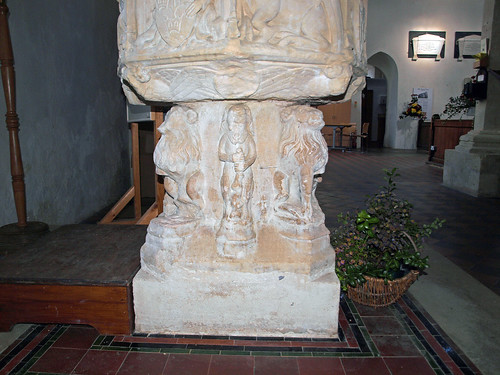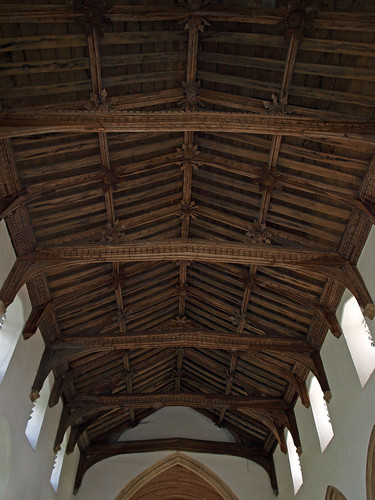Inside all is much restored but the nave and south aisle roofs are pleasing [I thought the angels in the south aisle were replicas, Pevsner seems to think not] and the font is excellent. Perhaps I'd been jaded by Gipping but I found it rather pedestrian.
ST MARY. All of c. 1330-40. Nave and chancel, S aisle and S porch tower. Inside the tower good doorway with two orders of slender shafts and a finely moulded arch. The S aisle E window has a very pretty enrichment of the usual reticulation motif. Each unit has a lozenge in the middle held by four bars. The W window has two cusped spherical triangles above the even three lights. The N windows of the nave are segment-headed, again with reticulation motifs. The five-bay arcade which separates the nave from the wide S aisle has octagonal piers and double-hollow-chamfered arches. Beautiful nave roof with alternating tie-beams on arched braces and arched braces meeting at the ridge. Large bosses. S aisle roof on demi-figures of angels. Smaller angels on the wall-plate as well. - FONT. Against the stem four ferocious seated lions and four Wild Men. Against the bowl the Signs of the Evangelists and angels holding shields. - PLATE. Elizabethan Cup; Set of 1758. - CURIOSA. In the porch hang thirty-three leather buckets of 1725 and 1757.
HAUGHLEY. Thatched houses are gathered in friendly fashion round its green, and an old mill waves its arms on the hill above. It has a stately Tudor house with battlemented bays and crow-stepped gables, and a flint church 600 years old. But the great surprise of this ancient town is in its High Street, the deep waters of a moat and a wooded mound of a Norman castle. The castle was captured and razed to the ground in 1173 during the struggle between the Kings and the Barons, but the mound remains, a stronghold, it is believed, of Danes and Saxons, the survivor of probably 20 centuries or more of unhurried but continuous change.
The 14th century nave of the church has a 15th century clerestory, and keeps its medieval roof with embattled beams and bosses of spreading leaves. There is some ancient glass in the west window with the heraldic arms of Hales Abbey, to which the church once belonged. The font is 500 years old, with angels on its bowl and lions with wild men with bludgeons guarding the base. There is an Elizabethan chalice, and in the porch hangs an old leather bucket. A vicar of last century, Edward Ward, was here for 56 years.
The 14th century nave of the church has a 15th century clerestory, and keeps its medieval roof with embattled beams and bosses of spreading leaves. There is some ancient glass in the west window with the heraldic arms of Hales Abbey, to which the church once belonged. The font is 500 years old, with angels on its bowl and lions with wild men with bludgeons guarding the base. There is an Elizabethan chalice, and in the porch hangs an old leather bucket. A vicar of last century, Edward Ward, was here for 56 years.



No comments:
Post a Comment